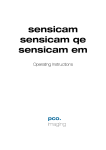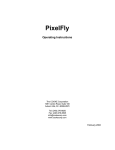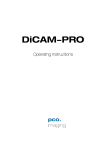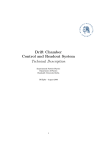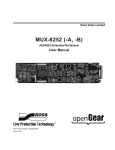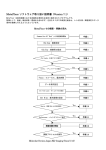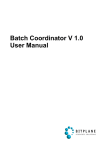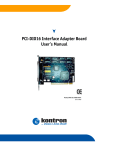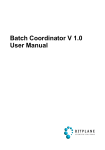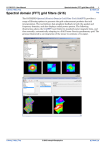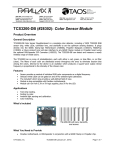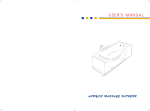Download SensiCam SensiCam QE Operating Instructions
Transcript
SensiCam SensiCam QE Operating Instructions The COOKE Corporation 1091 Centre Road, Suite 100 Auburn Hills, MI 48326-2670 Tel: (248) 276-8820 Fax: (248) 276-8825 [email protected] www.cookecorp.com February 2002 SensiCam/SensiCam QE Manual 2 Safety Instructions For your own safety and in order to guarantee safe operation of the camera, please read carefully the following information prior to using the device. -Never operate the camera at places where water or dust might penetrate. -Place the camera on a sufficiently stable base. Shocks like e.g. dropping the camera onto the floor might cause serious damage to the device. The tripod attachment on the bottom side should be used for mounting the camera. -Always unplug the camera before cleaning it. Do not use cleaning liquids or sprays. Instead, use a dry, soft duster. -Never insert any objects through the device's slots. The applied voltage inside the camera can cause short-circuits or electrical shocks. -The slots in the camera housing (bottom and rear panel) are needed for ventilation. In order to guarantee a proper operation and to prevent overheating of the camera, these slots must always be kept clear. -Make sure that the connecting cable is in good condition and that the link to the socket is not obstructed. -Detach the camera and contact customer service in the following cases: -When cable or plug is damaged or worn-out. -When water or other liquids have soaked into the device. -When the device is not properly working although you followed all instructions of the user's manual. -When the camera fell to the floor or the housing has been damaged. -When the device shows apparent deviations of normal operation. The COOKE Corporation 1091 Centre Road, Suite 100, Auburn Hills, MI 48326-2670 Tel: (248) 276-8820 Fax: (248) 276-8825 [email protected], www.cookecorp.com SensiCam/SensiCam QE Manual 3 Contents 1. Installation and Powering Up 1.1 Computer ........................................................................................... 5 System Requirements ..................................................................... 5 Graphic Setup.................................................................................... 5 Installing the PCI-Board................................................................... 6 1.2 Installation of the Hardware Driver.............................................. 7 Installation under Windows 9x/ME/2000 ...................................... 7 Installation under Windows NT...................................................... 7 Installation under Linux.................................................................... 7 1.3 Installation of the Software “CamWare” ................................... 8 1.4 Camera and PCI-Board................................................................... 9 Serial Data Transfer via Coaxial Cable......................................... 9 Serial Data Transfer via FOL.........................................................10 Lens Mount.......................................................................................10 Back Focal Length Adjustment.....................................................11 Filter Installation..............................................................................11 1.5 Powering Up....................................................................................12 2. Functional Principle 2.1 2.2 2.3 Block Diagram and Internal Data Stream ..................................13 Color Definition Algorithm .............................................................16 Operating several Cameras from one Computer.....................17 3. Timing 3.1 3.2 3.2.1 3.2.2 3.3 3.4 SensiCam High Performance ......................................................17 SensiCam High Speed..................................................................18 SensiCam High Speed in Standard Mode.................................18 SensiCam High Speed in Cycle Mode .......................................19 SensiCam DoubleShutter.............................................................20 SensiCam QE..................................................................................21 4. Trigger Control External Triggering..........................................................................22 Internal Triggering...........................................................................23 TRIG IN Socket at the PCI-Board .................................................24 Jack Plug Socket at the PCI-Board..............................................26 LED on thePCI-Board.....................................................................26 The COOKE Corporation 1091 Centre Road, Suite 100, Auburn Hills, MI 48326-2670 Tel: (248) 276-8820 Fax: (248) 276-8825 [email protected], www.cookecorp.com SensiCam/SensiCam QE Manual 5. 4 Software Application Software “CamWare”.................................................27 Plug-Ins.............................................................................................27 Software Development Kit (SDK).................................................27 Drivers ...............................................................................................27 6. Cooling Options Water Cooling..................................................................................28 Detached Fan Cooling ...................................................................28 7. Servicing, Maintenance and Cleaning Instructions Servicing, Maintenance and Cleaning Instructions ..................29 Cleaning Method for the Optical Part...........................................29 Cleaning Method for the FOL ........................................................30 6. Appendix Customer Service ...........................................................................31 Warranty............................................................................................31 CE-Certification ...............................................................................31 Dimensions and Weight................................................................32 System Data.....................................................................................33 Spectral Response.........................................................................35 The COOKE Corporation 1091 Centre Road, Suite 100, Auburn Hills, MI 48326-2670 Tel: (248) 276-8820 Fax: (248) 276-8825 [email protected], www.cookecorp.com SensiCam/SensiCam QE Manual 5 1. Installation and Powering Up The SensiCam imaging system consists of camera and PCI-Board. To get the system working properly, follow the instructions. 1.1 Computer System Requirements The PCI-Board should be installed in a computer with following characteristics: -PCI-Bus with PCI-Chip Version 2.1 or higher -Intel Processor, Pentium or AMD -128 MB RAM -Possible Operating Systems -Microsoft Windows 95 Version 4.00.950b or higher -Microsoft Windows 98 or 98SE -Windows ME -Microsoft Windows NT 4.0 Workstation -Microsoft Windows 2000 Workstation -Windows XP Professional -Linux Kernel 2.2, preferable SuSE 6.3 or newer Please contact COOKE for more information on Linux support for our cameras. Note: Drivers for our cameras are optimized for best performance. This may have implications for some dual-processor systems. If you are planning to use a dual processor computer in your imaging application, please contact Cooke technical suport for more information Display Adaptor For best display of images on the monitor we recommend the use of high performance boards with at least 8MB RAM, preferably with AGP Bus architecture. Graphic Setup The camera generates 12 Bit (4096 grey levels) images. For display on the PC Monitor 8 Bit (256 grey levels) respectively 3x8 Bit in true color (16,7 millions colors) are generated. In general, several graphic setups are possible. We recommend the setting with 24 or 32 Bit with 16.7 million colors. In Windows, use the “settings” tab in the “Display Properties” to set “colors” to at least 24 bit, and “size” the desktop to 1024 x 768. The COOKE Corporation 1091 Centre Road, Suite 100, Auburn Hills, MI 48326-2670 Tel: (248) 276-8820 Fax: (248) 276-8825 [email protected], www.cookecorp.com SensiCam/SensiCam QE Manual 6 Installing the PCI-Board Caution! Before touching the PCI-Board make sure you have not accumulated static charges. A discharge may destroy the sensitive electronics and voids any guarantee. Insert the PCI-Board in a free PCI-slot of your computer and screw the bow onto the PC housing. Make sure the board does not touch any electrical conducting parts (housing, other boards, wires or fans) It is essential to use a master PCI-slot. Some computers require additional enabling of PCI-slot mastering on BIOS level. The COOKE Corporation 1091 Centre Road, Suite 100, Auburn Hills, MI 48326-2670 Tel: (248) 276-8820 Fax: (248) 276-8825 [email protected], www.cookecorp.com SensiCam/SensiCam QE Manual 7 1.2 Installation of the Hardware Driver You can operate the camera with Windows9x/ME/2000/NT or Linux. Installation under Windows 9x/ME/2000/XP New-Installation of the hardware driver If you have Windows9x/ME/XP or Windows 2000 installed, the computer should automatically recognize the new hardware (PCI-Board) and request you to insert a disk with the manufacturer's drivers. These drivers are located on the CD that was supplied with your camera. See the “Quick Install guide” supplied with your CD for more details. Updating the hardware driver For updating an existing driver, please download the newest driver version from the internet under http://www.cookecorp.com. For installation please read the actual information in the readme.txt file, which will download automatically with the driver. If the downloaded drivers are compressed you have to decompress them with a suitable program (e.g. ZIP program). Installation under Windows NT Installation of the Hardware Driver If you install the camera under Windows NT, you need administrator privileges. Please login as administrator. A “setup.exe” file is provided on the CD supplied with the camera for driver installation. See the “Quick Install guide” for more information. Installation under Linux Please contact Cooke customer support for more information on Linux support for our cameras. The COOKE Corporation 1091 Centre Road, Suite 100, Auburn Hills, MI 48326-2670 Tel: (248) 276-8820 Fax: (248) 276-8825 [email protected], www.cookecorp.com SensiCam/SensiCam QE Manual 8 1.3 Installation of “CamWare” CamWare is a 32 Bit Windows application. With CamWare all camera parameters can be set. The images can be displayed on the monitor and saved on hard disk. For detailed information please see the separate manual “CamWare”. You will find the software CamWare on the CD supplied with your SensiCam. The newest version can also be downloaded from the internet under http://www.cookecorp.com. Installation from CD Refer to the “Quick Install guide” supplied with your SensiCam for details on software installation. Installation from Internet Download CamWare from the Internet to a free selected directory. The downloaded file must be decompressed with a suitable program (e.g. ZIP program) Start the installation with “setup.exe”. The latest information how to install CamWare can be found in the “readme.txt” file. Note To install CamWare under Windows 2000 and Windows NT you need administrator privileges. Note After successful installation the computer has to be restarted. The installation program transfers all necessary DLL and OLE files to the system folders, checking automatically for existing older versions and replacing them by new ones. In Windows all “registry“-entries are made automatically. If the program is to be deleted from the computer, remove it using “Addremove” software from the Windows control panel. After successful installation you will have the new directory ‘Digital Camera Toolbox’. CamWare and some additional useful tools will be installed to this directory. Hotline If you have problems during installation, contact customer service. The COOKE Corporation 1091 Centre Road, Suite 100, Auburn Hills, MI 48326-2670 Tel: (248) 276-8820 Fax: (248) 276-8825 [email protected], www.cookecorp.com SensiCam/SensiCam QE Manual 9 1.4 Camera and PCI-Board Before Powering Up, make following connections: -Power from Power Supply to Camera -Serial Interface between camera and PCI-Board with enclosed cables. There is a serial data transfer between camera and PCI-Board. Depending on version, either a double coaxial cable or a fiber optic (FOL) cable is used. If you have a camera version with FOL, go to the next page. Double-Coaxial Cable Connect the one end of the double-coaxial cable that comes with the camera to the two BNC-sockets at the rear of the camera and the other to the PCI-Board. The cables must be crossed, i.e. Tx on the camera connected to Rx on the board and Rx to Tx. Improper connections cause the LED (Display of Power Status) to stay on red (see also chapter 1.5). Operating LED Tx Rx POWER TRIG IN Tx Rx PCI-Interface-Board Camera If other than delivered cables are to be used, make sure they have an impedance of 50O. The maximum cable length for proper operation is 10m. The COOKE Corporation 1091 Centre Road, Suite 100, Auburn Hills, MI 48326-2670 Tel: (248) 276-8820 Fax: (248) 276-8825 [email protected], www.cookecorp.com SensiCam/SensiCam QE Manual Fiber Optic Link (FOL) 10 Remove the protection caps from the camera and the PCI-Board. Also remove gently the small caps from either end of the cable and keep them in a safety place!. Plug in the cable on both devices. Because of the plug shape the cables cannot be mixed up. The plugs should slip in easily. Avoid forcing! Operating LED POWER TRIG IN PCI-Interface-Board Caution! Lens Mount Camera Avoid kinking or bending the cable over a sharp edge. This will break the core and destroy the cable. The minimum-bending radius is 100mm! When shipping or storing the camera avoid touching the ends with bare fingers and replace the caps on the cable, camera and board to protect the sensitive optical surfaces from dust. SensiCam has a standard C-Mount with a back focal length of 17.52mm (Distance between front edge of C-Mount and CCD-sensor). Standard C-Mount lenses or other lenses with their respective C-Mount adapter (e.g. photo camera lenses) can be used. The maximum screw-in depth of a lens (or adapter) is 9.5mm. Any deeper could destroy the protecting window of the camera and void the warranty. Cameras with a color sensor can be equipped optionally with a BG39 filter. This filter will be placed at the C-Mount ring. In this case the maximum screw-in depth is only 6mm instead of the 9.5mm. The camera has either a ½” or 2/3” sensor. We recommend using for all SensiCam Versions a 2/3“ or 1“ compatible lens. Cameras with highresolution sensor should be equipped with a high quality lens to take advantage of the high resolution. . The COOKE Corporation 1091 Centre Road, Suite 100, Auburn Hills, MI 48326-2670 Tel: (248) 276-8820 Fax: (248) 276-8825 [email protected], www.cookecorp.com SensiCam/SensiCam QE Manual 11 Back Focal Length Adjustment It may be necessary to adjust the back focal length. If the camera cannot be focused to infinity. Loosen the two small allen screws at the knurled steel C-Mount to insert with the allen key provided and rotate the insert (M50x0.5 thread) to the desired position. To adjust to infinity, the lens must be set to infinity and the steel ring must be moved until you get a focused image. Secure the insert again by tightening the allen screws. Do not overtighten. Insert Filters Filters can be set in front of the CCD (e.g. a BG39 filter). For this purpose loose the two small allen screws at the bare steel C-Mount insert using the included allen screw key. The C-Mount insert should be removed. At the rear side of the C-Mount a milled recess accommodates a filter of 25mm diameter and maximum thickness of 2mm. After mounting the filter, screw in the C-Mount insert, adjust it to the necessary back focal length to get a sharp image and tighten the allen screws again. The COOKE Corporation 1091 Centre Road, Suite 100, Auburn Hills, MI 48326-2670 Tel: (248) 276-8820 Fax: (248) 276-8825 [email protected], www.cookecorp.com SensiCam/SensiCam QE Manual 12 1.5 Powering Up Check the following points: -PCI-Board properly mounted and secured to the back panel? -Camera-Board connection via double coaxial cable or FOL properly made? -Power supply connected to camera, to main? -Objective lens mounted? Switch on the computer Switch the computer on but do not start yet the program CamWare Switch on the camera Switch the camera on by pressing the POWER button on the rear panel of the device. Observe the operation display (LED). If the camera is properly attached, the LED will flash red-green for approx. 3 minutes. During this time, the system is cooled down to a temperature of between –11 and -15 degrees Centigrade (5 degrees Fahrenheit). Subsequently, the diode will change to permanently green, indicating that the correct operation temperature has been reached and that you can now start measuring. If the diode shows a permanent red, a hardware error has occurred, and you should check that the camera cable is properly attached. If the LED stays red, contact Cooke customer service. The following table lists possible reasons for hardware errors. Possible states of the LED LED color red continuous red/green intermittent Green continuous Starting CamWare Status Hardware error! ?? Connection of Camera and PCI-Board mixed up or interrupted (check whether Tx is on Rx and vice versa) ?? Defective cable ?? Computer off ?? Temperature on CCD sensor above 65?C (causing automatic camera switch off) System ready, however CCD has not yet reached its optimum temperature. After a few minutes LED should change to continuous green. If the intermittent state is going on constantly, there could be an error with the cooling. In this case please contact COOKE. System ready! Now start the program “CamWare“ from the directory Digital Camera ToolBox. For detailed information to CamWare please see the separate “CamWare” manual. The COOKE Corporation 1091 Centre Road, Suite 100, Auburn Hills, MI 48326-2670 Tel: (248) 276-8820 Fax: (248) 276-8825 [email protected], www.cookecorp.com SensiCam/SensiCam QE Manual 13 2. Functional Principle The images, captured by the camera head, will be transferred via a highspeed data transfer to the PCI-Board in the computer. Data is then transferred by DMA to system memory. With “CamWare” the camera can be controlled within the Windows environment and the images can be displayed on the monitor. The Recorder function allows you to record image sequences and display them as "movies". The maximum memory space for the recorded images depends solely on the RAM size of your computer. When starting the program, the software automatically recognizes the camera type. For detailed information please see the separate “CamWare” manual. 2.1 Block Diagram and Data Stream Block Diagram In the following block diagram the structure of the complete camera system is shown. The COOKE Corporation 1091 Centre Road, Suite 100, Auburn Hills, MI 48326-2670 Tel: (248) 276-8820 Fax: (248) 276-8825 [email protected], www.cookecorp.com SensiCam/SensiCam QE Manual 14 Internal Data Stream of black/white cameras The PCI-Board gets the 12bit data from the camera and transfers it via PCIBus to a 16bit array (in the PC Memory). The higher 4bits are set to zero. The 16bit data are converted to an 8bit array for display. Depending on graphic board set up display on the monitor is 24 or 32 bit RGB data. For monochrome cameras, the R G and B values are made equal. File Formats The command ‘Export’ stores 16bit or 8bit data on hard disk in B16, TIFF, FITS, BMP, or ASCII format. For further information see the “CamWare” manual. Display The camera acquires 12 bit images resolves with 4096 (212) grey levels between black and white, however the monitor display of the image is always limited to 8 bit and therefore to 256 (28) grey levels. The command ‘Convert Control’ allows to select a range between 0 ... 4095 grey levels, which is then displayed in 256 grey levels on the PC monitor. PC Monitor Camera PCI-Interface-Board Graphic Board PCI-Bus The COOKE Corporation 1091 Centre Road, Suite 100, Auburn Hills, MI 48326-2670 Tel: (248) 276-8820 Fax: (248) 276-8825 [email protected], www.cookecorp.com SensiCam/SensiCam QE Manual 15 Internal Data Stream of color cameras The PCI-Board gets the 12bit data from the camera and transfers it via PCIBus to a 16bit array (of the PC memory). The higher 4bits are set to zero. The 16 bit data are converted automatically into a 3 x 8 bit array and for display. We recommend displaying it in 32bits on the monitor. File Formats The command ‘Export’ stores 16bit or 8bit data on hard disk in B16, TIFF, FITS, BMP, or ASCII format. For further information see the CamWare manual. Display The camera which acquires always 12 bit images resolves with 4096 (212) grey levels between black and white, however the monitor display of the image is always limited to 8 bit and therefore to 256 (28) grey levels. The command ‘Convert Control’ selects a range between 0 ... 4095 grey levels, which is then displayed in 256 grey levels on the PC monitor. The R, G & B channels can be set separately. PC Monitor Camera PCI-Interface-Board Graphic Board PCI-Bus The COOKE Corporation 1091 Centre Road, Suite 100, Auburn Hills, MI 48326-2670 Tel: (248) 276-8820 Fax: (248) 276-8825 [email protected], www.cookecorp.com SensiCam/SensiCam QE Manual 16 2.2 Color Definition Algorithm Color sensors with RGB filter for the colors red, green and blue are used for the color cameras. The CCD sensor records for each pixel the light information as grey level with 12 Bit dynamic range (RX, GX, BX). With the help of the camera control software, for each pixel the 12 Bit data is converted by interpolating into an 8 Bit triplet (PRED, PGREEN, PBLUE ). For this interpolation following algorithm is applied: Algorithm 1 This algorithm optimises the color resolution. A red, green and blue part of the color for virtual pixels will be calculated. These virtual pixels are placed between the original pixels. In CamWare, this algorithm is called ‘Smooth’. -The first pixel on the top left side is always "red". -Between the physical pixels, there are virtual pixels PX, which are computed with the algorithm, described below. Physical Pixel R1 G2 R3 G4 G5 B6 G7 B8 R9 PX G10 R11 G12 G13 B14 B16 G15 ... Virtual Pixel ... Conversion algorithm for the new pixel PX: PRED = ( 9 R11 + 3 R3 + 3 R9 + R1 )/16 PGREEN = ( G7 + G10 )/2 PBLUE = ( 9 B6 + 3 B8 + 3 B14 + B16 )/16 Algorithm 2 This algorithm optimises the spatial resolution. For each physical pixel, a color value (red, green and blue) is calculated, related to the corresponding neighbour pixel. Example for Pixel6 PRED = ( R1 + R3 + R9 + R11 )/4 PGREEN = ( G2 + G5 + G7 + G10 )/4 PBLUE = B6 Example for Pixel7 PRED = ( R3 + R11 )/2 PGREEN = G7 PBLUE = ( B6 + B8 )/2 The COOKE Corporation 1091 Centre Road, Suite 100, Auburn Hills, MI 48326-2670 Tel: (248) 276-8820 Fax: (248) 276-8825 [email protected], www.cookecorp.com SensiCam/SensiCam QE Manual 17 2.3 Operating several Cameras from one Computer You can operate up to four cameras from one computer. The corresponding PCI boards have to be installed in the computer. For detailed information about operating the cameras please see the separate ‘CamWare’ manual. 3. Timing 3.1 SensiCam High Performance With the SensiCam High Performance and our standard software you can realize exposure times between 1ms and 1000s. For more information on how to obtain longer exposure times, contact Cooke technical support. The exposure (sequence) will be started with an internal or external trigger signal. The incoming light will be integrated on the CCD sensor and read out as 12 bit data to the PC. Along with the free programmable delay- and exposure times there are also system times (phase in, system time, CCD readout time) that have an influence to the camera timing. Please find the detailed camera timing in the following overview. Internal / external trigger Phase in VGA SuperVGA 0 ... 63.5µs 0 ... 117.3µs Delay Setting 0 ... 1000s 0 ... 1000s System Time 117.3µs Exposure Time CCD Readout 1ms ... 1000s 1ms ... 1000s Time Depending of CCD, Binning, ROI CCD readout time The actual readout time is displayed in the info field of the Camera Control window. Info field in the Camera Control window CCD readout time Image repetition rate (fps) The COOKE Corporation 1091 Centre Road, Suite 100, Auburn Hills, MI 48326-2670 Tel: (248) 276-8820 Fax: (248) 276-8825 [email protected], www.cookecorp.com SensiCam/SensiCam QE Manual 18 3.2 SensiCam High Speed The SensiCam High Speed can be operated in the Standard Mode and in the Fast Cycles Mode. In the field ‘Options’ you can select the desired mode. For each mode you will get a separate Camera Control window. 3.2.1 SensiCam High Speed in Standard Mode In the standard mode you can make single and multiple exposures with times between 100ns and 1ms. The multiple exposure allows you to make maximum 10 pairs of delay and exposure, with our standard software. For information on generating more than 10 delay/exposure pairs, contact Cooke technical support. The exposure must be started by an internal or external trigger signal (one trigger pulse for the complete multiple exposure). The digital 12-bit image will be read out from the CCD immediately after the exposure. If you want to write a sequence of exposures into the allocated memory buffer, you have to trigger each single exposure and each multiple exposure block separately. Along with the programmable delay- and exposure times there are also system times (phase in, intrinsic, CCD readout time) that have an influence to the camera timing. Please find the detailed camera timing in the following overview. Exposure 1 Phase in VGA SuperVGA Intrinsic 0 ... 40ns 0 ... 40ns Delay 1 Exposure 1 D2 0 ... 1ms 100ns ... 1ms 0 ... 1ms 100ns ... 1ms Depending of cable Exp. 2 E2 ..... CCD Readout ... ... Time Depending of CCD, Binning, ROI Intrinsic time CCD readout time 1.64µs at 5m double coaxial 1.66µs at 10m FOL 1.85µs at 50m FOL *) The actual readout time is displayed in the info field of the Camera Control window. *) the delay at FOL is 4.7ns/m Info field in the Camera Control window CCD readout time Image repetition rate (fps) The COOKE Corporation 1091 Centre Road, Suite 100, Auburn Hills, MI 48326-2670 Tel: (248) 276-8820 Fax: (248) 276-8825 [email protected], www.cookecorp.com SensiCam/SensiCam QE Manual 19 3.2.2 SensiCam High Speed in Cycles Mode In the Fast Cycles Mode up to five blocks can be programmed. Every block consists of delay-, exposure time and cycle counter. In the cycle counter you select the number repeating the pair delay and exposure. Each time the camera is triggered (externally) a delay exposure pair is executed, and the cycle counter decremented. The exposures of all five blocks will be integrated on the sensor to one single image. After the last exposed cycle in block five the sensor will be read out, not before! Each exposure must be triggered separately (also within the blocks)! Along with the programmable delay- and exposure times there are also system times (phase in, intrinsic, CCD readout time) that have an influence to the camera timing. Please find the detailed camera timing in the following overview. External Trigger Phase In VGA SuperVGA Intrinsic D1 E1 D1 E1 ..... Cycle 1 0 ... 40ns 0 ... 40ns D2 E2 ..... CCD-Readout Cycle 2 Depending of cable Time Depending of CCD, Binning, ROI Intrinsic time CCD readout time 1.64µs at 5m double coaxial 1.66µs at 10m FOL 1.85µs at 50m FOL *) The actual readout time is displayed in the info field of the Camera Control window. *) the delay at FOL is 4.7ns/m Info field in the Camera Control window CCD readout time Image repetition rate (fps) The COOKE Corporation 1091 Centre Road, Suite 100, Auburn Hills, MI 48326-2670 Tel: (248) 276-8820 Fax: (248) 276-8825 [email protected], www.cookecorp.com SensiCam/SensiCam QE Manual 20 3.3 SensiCam DoubleShutter With the SensiCam DoubleShutter you can make two separate images with full resolution (1280 x 1024 with SVGA sensor or 640 x 480 with VGA sensor). The minimum time between the two images is 200ns. The integration time for the 1st image is defined by the user by setting the length of the externally given signal TRIG IN. The characteristic range is from 1µs to 10ms. The integration time of the 2nd image is exclusively determined by the CCD readout time for the 1st picture. This means, the user has no direct influence on the duration of the second integration time and thus on the second exposure. If a shorter exposure time is required within the time window of the second integration time, an external control should be used, e.g. by Laser, flash, mechanical shutter, … In that case the environment light should be darkened. Along with the programmable delay- and exposure times there are also system times (phase in, intrinsic, dead time, CCD readout time) that have an influence to the camera timing. Please find the detailed camera timing in the following overview. Remark The SensiCam DoubleShutter also has all features of the SensiCam High Speed. Dead time Depending of the selected mode: In DOUBLE short mode: 200 ns In DOUBLE long mode: 1 µs Intrinsic times 1.24µs at 5m double coaxial 1.26µs at 10m FOL 1.45µs at 50m FOL *) *) the delay at FOL is 4.7ns/m CCD readout time The actual readout time is displayed in the info field of the Cam era Control window (see above). The COOKE Corporation 1091 Centre Road, Suite 100, Auburn Hills, MI 48326-2670 Tel: (248) 276-8820 Fax: (248) 276-8825 [email protected], www.cookecorp.com SensiCam/SensiCam QE Manual 21 3.4 SensiCam QE With the SensiCam QE and standard software you can program exposure times between 1ms and 1000s. For information on programming longer exposure times contact Cooke technical support. The exposure or sequence will be started with an internal or external trigger signal. The incoming light will be integrated on the CCD sensor and read out as 12 bit data to the PC. In addition, to the programmable delay- and exposure times there are also system times (phase in, system time, CCD readout time) that have an influence to the camera timing. Please find the detailed camera timing in the following overview. Internal / external triggerr Phase in QE 0 ... 95,5µs Delay Setting 0 ... 1000s System Time Exposure Time 95,5µs 1ms ... 1000s CCD Readout time Depending of CCD, Binning, ROI CCD readout time The actual readout time is displayed in the info field of the Camera Control window. Info field in the Camera Control window CCD readout time Image repetition rate (fps) The COOKE Corporation 1091 Centre Road, Suite 100, Auburn Hills, MI 48326-2670 Tel: (248) 276-8820 Fax: (248) 276-8825 [email protected], www.cookecorp.com SensiCam/SensiCam QE Manual 22 4. Trigger Control The SensiCam can be triggered internally or externally. Depending on the camera version, you have the following trigger mode. A detailed timing of each camera version you will find in chapter 3. SensiCam High Performance and SensiCam QE external triggering, external falling edge external triggering, external rising edge internal triggering, auto sequential internal triggering, auto simultaneous SensiCam High Speed (Standard Mode) external triggering, external falling edge external triggering, external rising edge internal triggering, auto sequential SensiCam High Speed (Fast Cycles Mode) external triggering, external falling edge external triggering, external rising edge SensiCam Double Shutter external triggering, external falling edge external triggering, external rising edge External trigger "external falling" and "external rising" External triggering is handled via a TTL signal (low = 0V, high = 5V) that is fed in through the BNC plug on the PCI-Board. The TTL signal can be both, "low active" (external falling) or "high active" (external rising). TRIG IN external falling = 1k? pull up external rising = 1k? pull down When not switched on, the trigger input is held at +5V, using a 1k? resistance. Thus, an external trigger signal might also produced by a shortcircuit toggle or switch closure. External Trigger Delay Exposure Readout wait for trigger ... Delay Exposure Readout ... Time Depending of CCD, Binning, ROI The COOKE Corporation 1091 Centre Road, Suite 100, Auburn Hills, MI 48326-2670 Tel: (248) 276-8820 Fax: (248) 276-8825 [email protected], www.cookecorp.com SensiCam/SensiCam QE Manual 23 Internal trigger "auto sequential" and "none" This trigger mode leads to a continuously repeated exposure of the chosen sequence. The defined delay and exposure times always start only after read out. Delay Exposure Readout Delay Exposure Readout ... Time Depending of CCD, Binning, ROI Internal trigger “auto simultaneous” This trigger mode allows you to expose while reading out. If the exposure time is set shorter than the read out time, you can obtain the maximum imaging frequency (which depends on the given CCD sensor and on the binning). Otherwise, the picture sequence frequency depends on the durance of the set exposure time. This mode does not allow delay time setting! Exposure time < CCD readout time Depending of CCD, Binning, ROI Readout Exp. Readout Exp. Readout Exp. Readout ... Exp. Time Exposure time > CCD readout time Depending of CCD, Binning, ROI Readout Readout Readout Readout Exposure Exposure Exposure Exposure ... The COOKE Corporation 1091 Centre Road, Suite 100, Auburn Hills, MI 48326-2670 Tel: (248) 276-8820 Fax: (248) 276-8825 [email protected], www.cookecorp.com Time SensiCam/SensiCam QE Manual 24 TRIG IN plug on the PCI-Board The BNC plug TRIG IN on the PCI-Board serves a triple purpose: TRIG IN PCI-Interface-Board Function 1: Trigger Input The camera system can be triggered via external, edge active TTL signal. Function 2: Control Output The BUSY signal and the EXPOS signal can be captured at this output. The same BUSY signal is available at the jack plug socket (see below). BUSY is active from the start of the trigger signal until writing into the PCIBoard buffer is complete. No exposure is started during this period. rising edge TRIG IN 22 kOhm TRIGGER falling edge TRIGGER BUSY 74HC14 BUSY falling edge TRIG IN TRIGGER rising edge TRIGGER 22 kOhm BUSY 74HC14 BUSY The COOKE Corporation 1091 Centre Road, Suite 100, Auburn Hills, MI 48326-2670 Tel: (248) 276-8820 Fax: (248) 276-8825 [email protected], www.cookecorp.com SensiCam/SensiCam QE Manual 25 TRIG IN 74HC14 TRIGGER falling or rising edge no BUSY Decoupling the trigger signal from BUSY or EXPOS: TRIG IN O.C. 7407 TRIGGER falling edge 74HC14 BUSY When using SensiCam High Performance or SensiCam QE an additional signal, called EXPOS, is available. EXPOS is active while exposing. It is a high active signal (TTL), beginning 1ms before the start of the exposure time (when delay ?1ms) and ending 5ms before the exposure time stops (when exposure time >5ms). EXPOS can only be used in internal triggering mode (auto sequential or auto simultaneous). Please contact us for detailed information. Function 3: Control of double exposure (Only for SensiCam DoubleShutter) The double exposure must be controlled via an external TTL trigger signal (TRIG IN). The timing in the following diagram corresponds to a SensiCam DoubleShutter with coaxial cable. 200ns dead time! 1240ns ? 20ns 920ns ? 20ns TRIG IN (BNC Socket) CCD readout time of Image 1 Inegration Time Image 1 1µs ... about 10ms CCD readout time of Image 2 Integration Time Image 2 Time automatically set by CCD, Binning und ROI Phase In + Intrinsic Depending of CCD, Binning, ROI The COOKE Corporation 1091 Centre Road, Suite 100, Auburn Hills, MI 48326-2670 Tel: (248) 276-8820 Fax: (248) 276-8825 [email protected], www.cookecorp.com SensiCam/SensiCam QE Manual 26 Jack Plug Socket at the PCI-Board NOTE: Interface board 525 only. The 3.5mm stereo jack plug socket at the PCI-Board has a double function: Function 1: BUSY Signal This control output signals if the camera is ready to accept a new trigger signal. While BUSY is active, an external trigger signal will be ignored. The BUSY signal edge depends of the selected trigger input edge of the TRIG IN signal. When the trigger input is falling edge (selected in the CameraControl window), an output signal low means the camera is busy, an output signal high means the cameras is ready to accept a new trigger signal. TRIG IN BUSY STORE Function 2: STORE Signal Control Output (high active) STORE signals the data transfer from the camera to the PCI-Board. Pin out LEDs at the PCI-Board There are two LEDs at the metal holder of the PCI-Board. (Interface 525 only) TRIG IN Green LED Control LED is lit when connection between camera and PCI-Board is correct. When the LED is off, there could be the following reasons: -Cable is not connected properly. When using coaxial cables, the Tx must be connected to Rx and Rx to Tx. -Cable defective Red LED This LED signals the DMA data transfer via the PCI-Bus from the PCI-Board memory to the computer RAM. The COOKE Corporation 1091 Centre Road, Suite 100, Auburn Hills, MI 48326-2670 Tel: (248) 276-8820 Fax: (248) 276-8825 [email protected], www.cookecorp.com SensiCam/SensiCam QE Manual 27 5. Software Application Software Shipment of the camera system includes the CamWare software, complete operation software for the camera allowing to display and to save images. For detailed information to CamWare please see the separate ‘CamWare’ manual. Plug-Ins In case you are already working with image processing or image analysis software appropriate Plug-Ins may be installed. Camera control can be performed directly from the image analysis software. SensiCam High Performance and QE cameras are supported by the following software. -OPTIMAS, version 6.1 and higher (Media Cybernetics) * -Image-Pro Plus, version 3.0 and higher (Media Cybernetics) * -MetaMorph / MetaFluor Software (Universal Imaging) -PMIS (GKRCC) -IPLab Software (Scanalytics) -LabView (National Instruments) -AxioVision (Carl Zeiss) -Axon Workbench (Axon Inc.) * indicates that the driver is on the CD provided with the camera. Please feel free to ask for information about these programs. In case your software is not listed above, please contact COOKE. Software Development Kit In case you have written your own software or you wish to include the control software into already existing programs, the camera control may be integrated as DLL file by using our Software Development Kit (SDK). The following SDK’s with detailed manual are available: -SDK for Windows 9x/ME/2000/NT -SDK for Linux The SDK can be found on the CD or can be downloaded from Internet under http://www.cookecorp.com. TWAIN Drivers: TWAIN drivers are also provided for Windows 9X/ME/2000/IXP/NT and Linux The drivers can be found on the CD or can be downloaded from Internet under http://www.cookecorp.com. The COOKE Corporation 1091 Centre Road, Suite 100, Auburn Hills, MI 48326-2670 Tel: (248) 276-8820 Fax: (248) 276-8825 [email protected], www.cookecorp.com SensiCam/SensiCam QE Manual 28 6. Cooling Options Cooling options prove to be very helpful in extremely critical optical settings, like e.g. special microscopes, preventing possible vibrations caused by the camera fan. The SensiCam system can be delivered with one of the following two cooling options. Remote fan cooling For this cooling option the camera fan is placed at the end of a flexible hose with a length of 4 m (13 feet) and a diameter of 25 mm (1/10 inch). The external fan can be positioned on the floor. The camera's power switch also switches the fan on or off. Water Cooling The generated heat is removed by a water circulation, instead of a ventilator. On the bottom side of the camera there are two connections for water inflow and outflow. Shipment of this version includes two 5-meter tubes with quick-plugs. Contact Cooke for more information on water requirements. The COOKE Corporation 1091 Centre Road, Suite 100, Auburn Hills, MI 48326-2670 Tel: (248) 276-8820 Fax: (248) 276-8825 [email protected], www.cookecorp.com SensiCam/SensiCam QE Manual 29 7. Servicing, Maintenance and Cleaning Instructions Servicing, Maintenance and Cleaning Instructions The camera is maintenance-free. Factory settings make any inspection and servicing superfluous. During use the camera should be protected from hard shocks or strong vibrations. Also, camera must be protected from high humidity and temperature shocks. Avoid exposing to sunlight, since it heats up the camera housing unnecessarily and prevents the cooling from reaching its optimum operating temperature. Keep apertures and slots free to allow air to circulate. Objective lens or lens adapter should be screwed in gently. Avoid forcing, as it will damage the tread. Use a soft and dry cloth to clean the housing. Cleaning Method for the Optical Part In principle every cleaning method bears the danger of damaging an optical surface. Therefore clean only if it is strictly necessary. As a first step, use dry air to blow out dust particles. Avoid strictly wiping on a dry glass surface. If dirt cannot be removed by blowing, use special optical cleaning fluids. Adequate fluids for optical surfaces are: pure dehydrogenated alcohol, pure acetone or cleaning fluids available in photo shops. Use a soaked cotton tip and take care to wipe only on glass surfaces, avoiding contact to metal surfaces, e.g. C-Mount thread, otherwise microscopic dirt and metallic chips are released, causing irreparable scratches on the glass surface. Cleaning solvents can damage the finish on the housing. Never use aggressive cleaning substances, e.g. benzine, spirit, nitro solvents, etc. commonly found in labs. Such substances may destroy or damage the surface on which they are applied. Hint The best is to avoid any dirt on optical parts, e.g. by replacing immediately the protection cap when removing the objective lens. Do not leave the camera’s optical input window open, without lens or protecting cap. Our warranty does not cover damaged optical surfaces caused by improper cleaning methods. The COOKE Corporation 1091 Centre Road, Suite 100, Auburn Hills, MI 48326-2670 Tel: (248) 276-8820 Fax: (248) 276-8825 [email protected], www.cookecorp.com SensiCam/SensiCam QE Manual 30 Cleaning Method for the FOL The core of the Fiber Optic Link is a 64µm diameter glass fiber. The connectors and the fiber itself should be cleaned only by dry dust free air. Again, after disconnecting, replace the protective caps on both camera and cables immediately. The COOKE Corporation 1091 Centre Road, Suite 100, Auburn Hills, MI 48326-2670 Tel: (248) 276-8820 Fax: (248) 276-8825 [email protected], www.cookecorp.com SensiCam/SensiCam QE Manual 31 8. Appendix Customer Service If you have a problem or a question about matters not handled in these operating Instructions, please contact: ... by Telephone ... by Fax ... by Email 1-866-66COOKE (1-866-662-6653) (248) 276-8825 [email protected] For a quicker reply we need following information: -Short description of the problem -Experiment conditions -Settings of delay and exposure time -Camera control software and version number -Camera serial number -PCI-Board serial number (520 ... or 525 ...) -Operating System -Processor type of your computer -Size of RAM -Type of graphic board -Graphic setup Attention Opening of the camera or improper handling (e.g. damage by electrostatic charge, wrong cleaning method) voids the warranty. CE-Certification SensiCam complies with the requirements of the “EMC Directions of the European Communities (089 / 336 / EWG)” and therefore bears the CEMarking. The COOKE Corporation 1091 Centre Road, Suite 100, Auburn Hills, MI 48326-2670 Tel: (248) 276-8820 Fax: (248) 276-8825 [email protected], www.cookecorp.com SensiCam/SensiCam QE Manual 32 Dimensions and Weight Side view of the SensiCam Front view of the SensiCam Tripod mount at the bottom 24 13 3/8-16 UNC thread 1/4-20 UNC thread Weight: 1.6 kg R 6.0 The COOKE Corporation 1091 Centre Road, Suite 100, Auburn Hills, MI 48326-2670 Tel: (248) 276-8820 Fax: (248) 276-8825 [email protected], www.cookecorp.com SensiCam/SensiCam QE Manual 33 System Data SensiCam Sensor Type Number of Pixels Pixel Size Sensor Format Scan Area Cooling Type CCD Temperature Full Well Capacity Scan Rate Readout Noise @12.5 MHz A/D-Converter A/D Conversion Factor Max. Quantum Efficiency monochrome, @ 520nm Spectral Response (monochrome) Spectral Response (color) Average Dark Charge 7) Extinction Ratio 1) Smear 2) Anti Blooming 3) CCD Quality Non-Linearity Readout Frequency (Full Frame) Binning Horizontal Binning Vertical Blemishes Point Defects 4) Cluster Defects 5) Column Defects 6) Warm Pixels 7) typ. # pixels > 100 e # pixels > 5 e # pixels > 1 e Non-Uniformity in darkness 8) typ. Non-Uniformity in brightness 9) typ. # pixels > 12% # pixels 8 ... 12% # pixels 4 ... 8% # pixels 2 ... 4% Optical Input Dimension Weight Operating Temperature Storage Temperature Humidity C-Mount Back Focal Length Maximum lens screw-in depth VGA SVGA SensiCam QE CCD-Interline Progressive Scan with “lens-on-chip“ 640(H) x 480(V) 1280(H) x 1024(V) 1376(H) x 1040(V) 9.9µm x 9.9µm 6.7µm x 6.7µm 6.45µm x 6.45µm 1/2“ 2/3“ 2/3“ 6.3mm x 4.8mm 8.6mm x 6.9mm 8.9mm x 6.7mm 2-stage peltier cooler with forced air cooling -15°C -12°C -12°C 35.000 e 25.000 e 18.000 e 12.5 MHz 12.5 MHz 16 MHz 13 ... 14 e 7 ... 8 e 4 ... 5 e - (Gain High) 5 ... 6 e - (Gain Low) 12 Bit @12.5MHz 12 Bit @16MHz 7.5 e -/count 5 e -/count 2 e -/count (Gain High) 4 e -/count (Gain Low) ? 40% ? 60% 280 ... 1000nm RGB primary colors < 0.1 e -/pixel.sec 1:2000 < 0.005% > 1000 grade 0 < 1% 30 fps 1...8 1...32 0 0 0 0 0-2 250 - 1000 1 count 0.2% 0 0 0 0-5 < 0.1 e -/pixel.sec 1:2000 < 0.005% > 1000 grade 0 < 1% 8 fps 0 0 0 not available < 0.1 e -/pixel.sec 1:2000 < 0.005% max. 100 grade 0 < 1% 10 fps 1…8 1...32 0 0 0 0 0 0-2 0-2 500 - 2000 500 - 2000 1 count 1 count 0.6% 0.6% 0 0 0-2 0-2 10 - 50 10 - 50 n.a. n.a. C-Mount with adjustable focus length Head: 93(W) x 78(H) x 210(L) mm 1.6 kg 0...40°C -20...+70°C 10...90% non condensing 17.92 mm 9.5mm (with optional filter glass: 6mm) x) See remarks on page 39. The COOKE Corporation 1091 Centre Road, Suite 100, Auburn Hills, MI 48326-2670 Tel: (248) 276-8820 Fax: (248) 276-8825 [email protected], www.cookecorp.com SensiCam/SensiCam QE Manual High Speed Serial Link High Speed Serial Link PCI-Interface Board Board Buffer RAM Trigger Input Exposure/ Delay Time Setting SensiCam HIGH PERFORMANCE Exposure/ Delay Time Setting SensiCam HIGH SPEED Exposure/ Delay Time Setting SensiCam DOUBLE SHUTTER Exposure/ Delay Time Setting SensiCam QE Power Supply Power Supply 34 standard: optional: coax cable ? 10m with BNC connectors fiber optic link ? 2000m with SC connectors PCI Local Bus compatible, revision 2.1 16 MByte TTL level (rising/falling edge); BNC connector 0 ... 1000s delay 1ms...1000s exposure 0 ... 1ms delay 100ns...1ms multiple exposure (free programmable) two separate exposures with min. 200ns delay 0 ... 1000s delay 1ms...1000s exposure Desktop AC/DC 90...260V/ 36W IEC connector x) See remarks on page 39. The COOKE Corporation 1091 Centre Road, Suite 100, Auburn Hills, MI 48326-2670 Tel: (248) 276-8820 Fax: (248) 276-8825 [email protected], www.cookecorp.com SensiCam/SensiCam QE Manual 35 Spectral Response (typical values) SensiCam High Performance SensiCam High Speed SensiCam DoubleShutter 60 50 40 QE [%] 30 20 10 0 300 350 400 450 500 550 600 700 800 900 1000 Wavelength [nm] SVGA Sensor VGA Sensor SensiCam QE 70 60 50 40 Q.E.[%] 30 20 10 0 300 400 500 600 700 800 900 1000 1100 Wavelength [nm] Standard Mode (Default) Low Light Mode The COOKE Corporation 1091 Centre Road, Suite 100, Auburn Hills, MI 48326-2670 Tel: (248) 276-8820 Fax: (248) 276-8825 [email protected], www.cookecorp.com SensiCam/SensiCam QE Manual 36 Definitions and Measurement Conditions 1) Extinction ratio It is the ratio of “electronic shutter off“ V off to “electronic shutter on“ V on. It is measured with an exposure time set to 100ns and a pulsed laser diode (20ns) illumination. During exposure window (100ns) light is attenuated by a factor of 1:1000 grey filter, while out of the exposure window filter is removed. V 1 E ? off ? Thus: V on 1000 2) Smear The CCD is set to 40ms exposure time with an uniform illumination to achieve 50% of saturation (V50). Then the electronic shutter is closed (readout clock is stopped, charge drain is performed by the electronic shutter) and the illumination is set to 500 times over exposure. After 40ms the CCD is read out. V 1 The measured output signal (VSm) is substituted in the following formula: Sm ? Sm ? ?100% V 50 500 3) Anti Blooming The factor of over exposure allowed to avoid blooming in the neighbouring pixels. 4) Point Defect Measured under Conditions A: A point defect is a pixel whose signal deviates by more than 3 counts from the mean value of 48 neighbouring pixels (7x7 array). Measured under Conditions B: A point defect is a pixel whose signal deviates by more than 12 % from the mean value of 48 neighbouring pixels (7x7 array). 5) Cluster Defect Measured under Conditions A. Is a group of 2 ... 6 contiguous defective pixels. 6) Column Defect, Row Defect Measured under Conditions A. Is a group of more than 6 contiguous defective pixels along a single column or row . 7) Warm Pixel / Dark Charge Measured under Conditions C. A pixel is considered a warm pixel, if it has an increased dark charge generation. No test for High Speed version. 8) Non-Uniformity in darkness, compared to neighbouring pixels Measured under Conditions A. Non-uniformity of a single pixel is the deviation in counts, compared to the mean value of 48 neighbouring pixels (7x7 array). 9) Non-Uniformity in brightness, compared to neighbouring pixels Measured under Conditions A or B. Non-uniformity of a single pixel is the deviation in %, compared to the mean value of 48 neighbouring pixels (7x7 array). n typical deviation d typ. ? ? 48 d x ? px ? dx 1 ? 1 with n = 307,200 for VGA (640 x 480 pixels) with n = 1,310,720 for SVGA (1280 x 1024 pn 48 dx = deviation of the tested pixel Px = pixel to test Pn = 48 neighbouring pixels (7x7 array) Conditions for measurement For all conditions the operating temperature is -15°C for VGA and -12°C for SVGA A : exposure time 40ms Binning H1, V1 256 images averaged dark field conditions B : exposure time 40ms Binning H1, V1 256 images averaged uniform illumination to yield 75% saturation (about 3,000 counts) C : exposure time 200 s Binning H1, V1 16 images averaged dark field conditions The COOKE Corporation 1091 Centre Road, Suite 100, Auburn Hills, MI 48326-2670 Tel: (248) 276-8820 Fax: (248) 276-8825 [email protected], www.cookecorp.com




































